Blackline Safety is a technology leader driving innovation in the industrial workforce through IoT (Internet of Things). With connected safety devices and predictive analytics, Blackline enables companies to drive towards zero safety incidents and improved operational performance. Blackline provides wearable devices, personal and area gas monitoring, cloud-connected software and data analytics to meet demanding safety challenges and enhance overall productivity for organizations with coverage in more than 100 countries. Armed with cellular and satellite connectivity, Blackline provides a lifeline to tens of thousands of people, having reported over 200 billion data-points and initiated over seven million emergency alerts. For more information, visit BlacklineSafety.com and connect with us on Facebook, Twitter, LinkedIn and Instagram.
How Connected Safety Proactively Reduces Risk to Oil and Gas Facilities and Workers
Blackline Safety, Leader in Connected Gas Detection & Lone Worker Safety
February 17, 2022
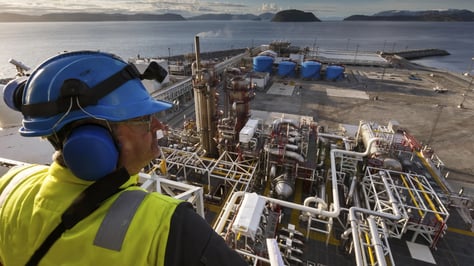 At every point in the oil and gas production supply chain, from the extraction of raw materials to transportation and storage, to refining and distribution processes, oil and gas operations require accurate, real-time monitoring of safety conditions. This immediate visibility can protect workers, facilities, and equipment from damage ensuring every worker gets home safe and sound at the end of the day.
At every point in the oil and gas production supply chain, from the extraction of raw materials to transportation and storage, to refining and distribution processes, oil and gas operations require accurate, real-time monitoring of safety conditions. This immediate visibility can protect workers, facilities, and equipment from damage ensuring every worker gets home safe and sound at the end of the day.
With the advent of digital transformation and IoT, connected safety solutions have up-leveled programs from reactive compliance to proactive incident prevention, reducing risks to facilities and people alike.
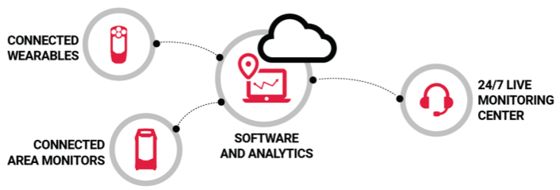
What is a connected safety solution?
Connected safety solutions are comprised of a network of cloud-connected devices, including area monitors and personal wearable devices that, when coupled with an online dashboard, provide full visibility into the safety of facilities and workers. The data streamed from those devices deliver powerful reporting capabilities to a manager’s fingertips, such as real-time compliance status (always able to ensure bump and calibrations are completed for the entire fleet of devices), but also that the devices are charged, turned on and actively being used throughout a shift. This information can be viewed from anywhere in real-time without the need to wait until after a device is docked to receive the data. Further data analysis can also identify and predict potential hazards so corrective action can be taken before they become an incident.
How do connected safety solutions reduce risks to facilities and workers?
The easiest way to explain connected safety is to provide examples from the field. Here are examples of common risks in the oil and gas industry and how connected safety solutions can reduce them.
Connecting lone and remote workers.
A frequent scenario in the oil and gas industry is working alone or in remote areas. This is especially true in upstream and midstream operations, where workers may travel to various locations throughout a shift, but it’s also the case in large downstream facilities where workers can be out of sight (and sound) from their peers. The types of hazards lone and remote workers face are diverse, including accidents while traveling, toxic or explosive gas exposures, health events, falls, inclement weather and even dangers from wildlife. 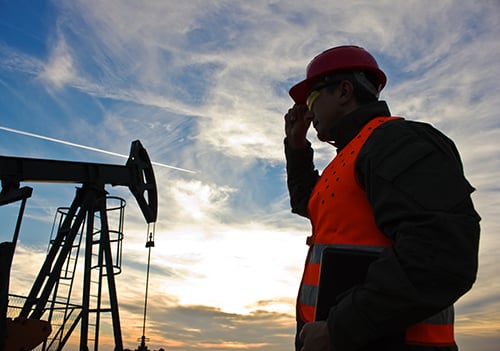 A connected safety solution uses wearable devices with sensors and functionality to automatically detect falls, lack of movement, and missed check-ins, any of which could indicate that a worker needs assistance. Lone workers can also activate SOS alerts to immediately connect them to safety monitoring personnel in the event of an incident requiring assistance. If exposure to toxic or flammable gases is a potential risk during their workday, lone worker devices are flexible and can be (re)configured to include single- or multi-gas detection capabilities. Real-time awareness of their people provides relief to safety team leaders knowing that someone is monitoring their people on an ongoing, uninterrupted basis should the worst occur.
A connected safety solution uses wearable devices with sensors and functionality to automatically detect falls, lack of movement, and missed check-ins, any of which could indicate that a worker needs assistance. Lone workers can also activate SOS alerts to immediately connect them to safety monitoring personnel in the event of an incident requiring assistance. If exposure to toxic or flammable gases is a potential risk during their workday, lone worker devices are flexible and can be (re)configured to include single- or multi-gas detection capabilities. Real-time awareness of their people provides relief to safety team leaders knowing that someone is monitoring their people on an ongoing, uninterrupted basis should the worst occur.
At many remote locations, cell service is limited, making it difficult for a worker to call for help and communicate with safety personnel if they are in a dangerous situation. The capabilities of satellite-connected safety devices, such as the Blackline G7x Multi-gas Pump Detector, to monitor and send critical data and worker location details and allow two-way text with safety personnel can be the difference between life and death. And if the work requires going to wellhead locations past the end of service roads, the magnetic satellite bridge can be easily moved from a truck to an ATV so the worker is always connected regardless of where the job takes them.
Protect your most valuable resource, your workers.
The fatality rate in the Oil & Gas industry is seven times greater than the rate amongst US workers in general - 25.1 / 100,000 / year. (CDC)
Continuous, real-time gas monitoring.
Because connected safety solutions continuously monitor gas levels in real-time, they can identify potentially hazardous levels before they become an incident and cause damage to facilities, equipment—and harm the workers that operate them.
A great example of continuous monitoring is confined space entries (CSE), such as storage tanks, mud pits, process vessels and trenches, which pose elevated risk because hazardous gases can quickly concentrate to dangerous levels or displace oxygen in poorly ventilated spaces.
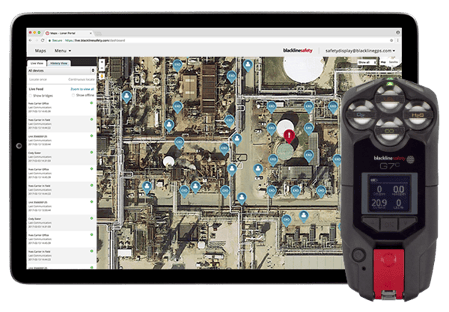 Using connected safety devices, such as Blackline's G7 EXO Area Monitor or G7c Multi-gas Pump Detector ensures these areas are safe for workers before they enter and alerts them to evacuate if gas levels exceed safe thresholds. And with an extended battery life of 100+ days, the EXO allows for extended CSEs without needing to re-permit.
Using connected safety devices, such as Blackline's G7 EXO Area Monitor or G7c Multi-gas Pump Detector ensures these areas are safe for workers before they enter and alerts them to evacuate if gas levels exceed safe thresholds. And with an extended battery life of 100+ days, the EXO allows for extended CSEs without needing to re-permit.
Continuous monitoring makes it possible to identify gas leaks preventing potentially catastrophic incidents. For example, 24/7 area gas monitoring can detect if a piece of equipment is gradually releasing more vapors into an area, indicating a need for repair or replacement. Because they are always connected, the gas readings can be viewed in real-time via the Blackline Live online dashboard.
Continuous monitoring needs to be considered in situations where a worker is in a space where atmospheric conditions have the potential to change (CCOHS).
Streamlining evacuation management.
Flammable gases released from wellbores, storage tanks, production equipment, surface equipment like shale shakers and other sources across work sites, present a significant risk of fire and explosion. In addition to explosive gases, there are several toxic gases in oil and gas production, such as hydrogen sulfide, that can leak and quickly lead to the need for an evacuation. In the event an emergency at a facility does happen, connected safety solutions also streamline reactive responses.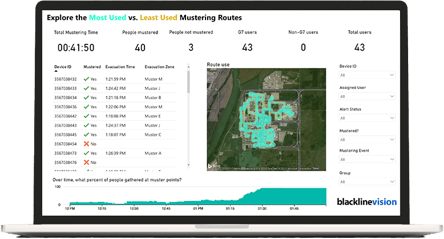 Continuous monitoring alerts safety personnel to sudden increases in the levels of hazardous gases, enabling quick evacuation of workers from affected areas, as well as ensuring no worker is left behind. During an evacuation, team leads can account for the location of every person wearing a connected safety device in real-time to ensure they safely reach muster points. Since worker locations can be seen on the Blackline Live portal, assistance can be sent directly to anyone that doesn’t safely evacuate, rather than doing manual headcounts and sending out search parties for anyone missing, saving critical seconds. Additionally, because connected devices capture a variety of data, rescue crews can determine the response needed whether it be a fall, no-motion or exposure to high levels of gas where SCBA equipment may be required.
Continuous monitoring alerts safety personnel to sudden increases in the levels of hazardous gases, enabling quick evacuation of workers from affected areas, as well as ensuring no worker is left behind. During an evacuation, team leads can account for the location of every person wearing a connected safety device in real-time to ensure they safely reach muster points. Since worker locations can be seen on the Blackline Live portal, assistance can be sent directly to anyone that doesn’t safely evacuate, rather than doing manual headcounts and sending out search parties for anyone missing, saving critical seconds. Additionally, because connected devices capture a variety of data, rescue crews can determine the response needed whether it be a fall, no-motion or exposure to high levels of gas where SCBA equipment may be required.
Fires and explosions are a leading cause of injuries and fatalities in the oil and gas industry (OHS Online).
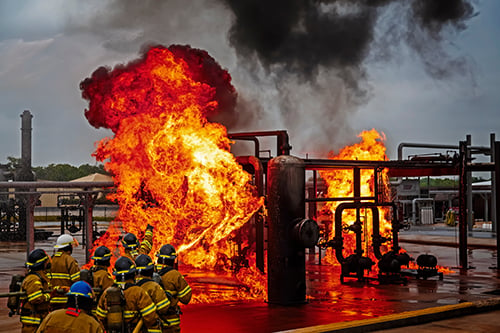 Predicting safety risks through data analytics.
Predicting safety risks through data analytics.
Unrecognized risks can exist in a facility or worksite location that can cause worker safety incidents or significant equipment damage resulting in unexpected downtime and costs. Connected safety solutions coupled with data science and analytics, such as that offered by Blackline Vision, can identify hazards before they harm workers or damage equipment. The ability to detect patterns through connected device readings allows safety managers and operators to take proactive steps.
For example, fall detection alerts in the same location may indicate a slippery surface from oil and grease, and if reports show it’s only seasonal, it may be due to an icy patch. Taking proactive measures by cleaning or de-icing to protect from serious falls keeps operations running smoothly and workers on the job.
On a larger scale, since all gas reading data is collected and streamed to the cloud, data analytics from connected devices can be used to indicate facility areas with potential risk. Gas levels below the threshold for alarms typically go unnoticed until an incident occurs. Reporting on these exposures gives operators the ability to proactively fix leaks or faulty equipment. Preventative maintenance can mitigate a potentially major rescue and repair event.
Conclusion
At every stage of oil and gas production—upstream, midstream, and downstream—connected safety solutions are an effective way to proactively prevent safety incidents from occurring to protect both workers and the facility, and to respond quickly to hazardous situations when they do arise.
Ready to learn more?
We’ve got even more resources at www.blacklinesafety.com/resources to help you.
Or visit our Oil and Gas page for industry specific content.
Get In Touch
Let’s start a discussion about your safety challenges and needs.
Related Blog Posts
Real-Life Incident: Mason’s Story — High H2S Exposure
November 25, 2025
“Shortness of breath. Request EMS to the location.” How Real-Time Gas Detection Led to a Quick Save Exposure to toxic gases can go from a strange...
3 Creative Applications of Blackline Safety Technology
July 29, 2025
Designed for Safety. Adapted with Ingenuity. Blackline devices are built for tough jobs—gas detection, lone worker monitoring, real-time emergency...
Real-Life Incident: Superior Fire Department Drug Bust
July 28, 2025
G7 helpsHAZMATteam safely navigate Wisconsin's largest DMT lab When Superior Wisconsin Fire Department received the call, the situation was...



